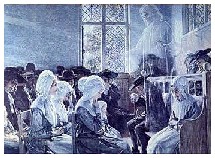


 |
 |
 |
In order to read this web page with the proper Hebrew characters, you'll need the "SPTiberian" font installed on your computer. The font is available free from the SP Fonts Home Page (click on "Macintosh" or "Windows" depending on which kind of computer you have). For Windows, scroll down the list to "SPTIBERI.TTF" and click on it. For Macintosh it's "SPTiberian.sit.hqx". If you're using a public computer (at a library or school) you'll probably need permission and/or help to install the font. If you're using your own computer but you don't know how to proceed, check out the Help function on your computer or ask your favorite techie.
In order to hear the sound files, you will need a sound card and appropriate software, such as Windows Media Player, QuickTime, RealPlayer (now RealOne™) or Winamp, any of which should work and all of which are available for free download. The sound files on this site are saved in .wav format.
| Lesson 1 | hwhy rme)Oy@2wa |
To hear the Lesson 1 sentence pronounced, click here.
| Lesson 2 | hwhy yni)j wylf)' rme)$y,2wa h#$em&-l)e MyhiOl)v rb@'day,:wa |
NOTE: I've been having great difficulty making the SPTiberian Hebrew script appear properly on the web page, at least when there's more than just a couple of characters. Please let me know if the above Lesson 2 sentence looks like the Hebrew script in the book. If not, just ignore the above and read the lesson sentence from the book. I won't write out any more sentences until I get this resolved. Thanks for your patience!
To hear the Lesson 2 sentence pronounced, click here.
Lesson 2 workbook answers (my answers anyway; if you disagree or have a question, please EMail me!):
| 2.2 | What kind of dagesh is in the y dagesh
forte (1.2) b@ = 2 What kind of dagesh is this? dagesh forte (1.2) | ||||||||||
| 2.3a | What is the initial |
||||||||||
| 2.3b | What is the y pronoun subject Form? prefix Person, Gender, Number? 3p m sg (1.3c, 1.4c) |
||||||||||
| 2.3d |
|
||||||||||
| 2.4 | What is the relationship of God to the verb? subject (1.6) | ||||||||||
| 2.7 |
|
||||||||||
| 2.8 | Using the chart, and reading from right to left, translate: and he said (1.5) | ||||||||||
| 2.10a | yni)j means I. hwhy means YHWH; Lord (1.1b) |
Lesson 2 Translation Exercises (Read the Hebrew in the textbook p. 11):
listen 1. And YHWH said to him
listen 2. And YHWH spoke to Moses and to Aaron
listen 3. And Moses said to Aaron
listen 4. And a king said
To hear the Lesson 3 sentence pronounced, click here.
Lesson 3 Translation Exercises (Read the Hebrew in the textbook p. 14):
listen 1. And Abraham went
listen 2. And Elohiym spoke to Noah
listen 3. And he went to him
listen 4. And Isaac went from there
listen 5. And Solomon said
To hear the Lesson 4 sentence pronounced, click here.
listen 1. The king did not see
listen 2. The man spoke
listen 3. And king Jehoiakim listened/obeyed
listen 4. And YHWH did not speak
listen 5. And he sent to King Hezekiah
listen 6. And Abram went as YHWH spoke to him